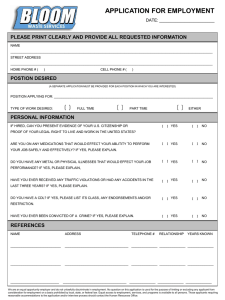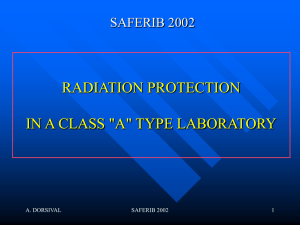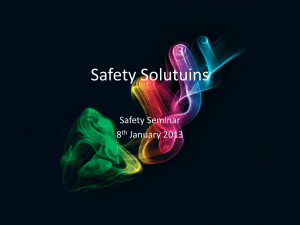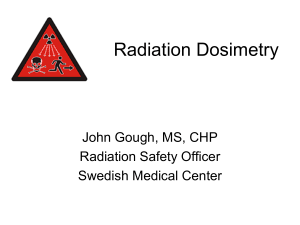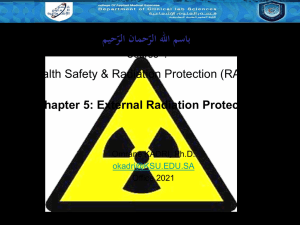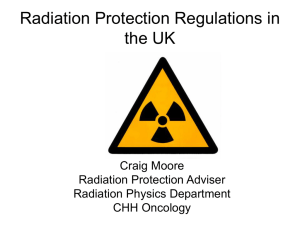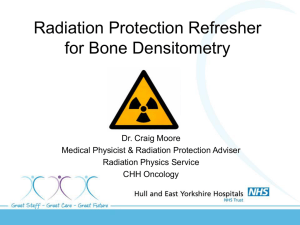Controlled areas
advertisement
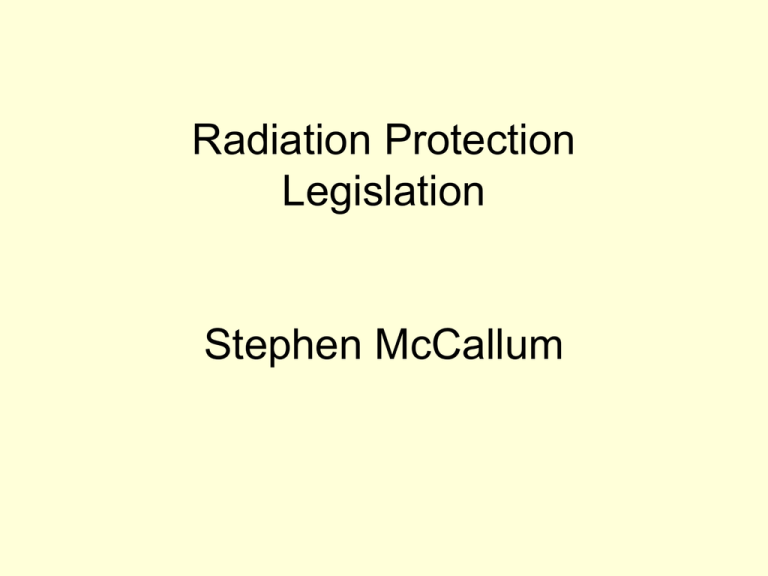
Radiation Protection Legislation Stephen McCallum Radiation Legislation The aim of legislation is to protect, individuals, populations and the environment from adverse affects of ionising radiation. Ionising Radiation Regulations 1999 Know as IRR99 - made under the Health and Safety at Work Act 1974. Enforcement agency is the Health and Safety Executive (HSE) Controls occupational exposures to workers and exposures to the public as a result of the use of ionising radiation in the work place Radioactive Substances Act 1993 RSA93, Enforcement agency is the Environment Agency (EA) in England & Wales and Scottish Environmental Protection Agency (SEPA) in Scotland Sets out regulatory frame work for the keeping of radioactive sources and the disposal of radioactive waste Route to legislation ICRP Guidance IAEA Guidance European directives UK law via an existing or new act of parliament IRR99 Employer responsibility Every radiation employer shall, in relation to any work with ionising radiation that he undertakes, take all necessary steps to restrict so far as is reasonably practicable the extent to which his employees and other persons are exposed to ionising radiation IRR99 – Dose Limits Whole Body effective dose (mSv) Eye Equivalent Dose (mSv) Skin Equivalent Dose (mSv) Hands, forearms, feet Equivalent Dose (mSv) Employees 20 150 500 500 Trainees 6 50 150 150 Others 1 15 50 50 IRR99 – Classified workers • A worker must be Classified if they are likely to receive a whole body dose of more than 6mSv per year or more than 3/10 of any relevant dose limit. • Classified workers must under a yearly medical by an doctor appointed by the employer. • Issued with a pass book detailing their dose record. • Are able to enter controlled areas • Personal Radiation doses must be monitored IRR99 – Non Classified workers • Classification not required for doses up to 3/10 of relevant dose limit i.e. 6mSv for body dose. • Only able to enter controlled area under a system of work drawn up by the employer. System of work normally part of the local rules • Personal Radiation dose often monitored to show that classification not required IRR99 – duties of employer • Carry out prior risk assessments before work commences This is one of the key elements of the legislation. From the risk assessment the employer should be able to determine the measures required to control and limit doses to staff and the public. IRR99 – duties of employer • Designation of areas Controlled areas under IRR99 should be set up where a person is likely to receive an effective whole body dose of more than 6mSv per year or where there is significant risk of spreading contamination outside the work area. Controlled areas • • • • • • Must be under the control of the employer Must be physically demarcated Must have suitable signage Local rules should be drawn up Radiation Protection Supervisor appointed Environmental and personal monitoring should take place Supervised areas • Any area where the conditions need to be kept under review • Any person is likely to receive an effective dose >1mSv/y or > than 1/10 of any other dose limit. • It does not automatically follow that outside every controlled area there will be a supervised area. IRR99 – duties of employer Draw up local rules • Required for every controlled area and normally every supervised area • Contain a key set of working instructions designed to restrict exposure. • Contingency plans if things go wrong. • Systems of work for non classified workers. • Must take steps to ensure rules or observed an brought to the attention of effected workers IRR99 – duties of employer Special consideration for pregnant and breast feeding workers Once notified must ensure the equivalent dose to the foetus is unlikely to exceed 1mSv during the remainder of the pregnancy; For breastfeeding mothers restrictions in place to prevent significant bodily contamination of that employee IRR99 – duties of employer Appointment of Radiation Protection Supervisor • Responsible for ensuring that the Local rules are adhered to and for supervising the arrangements. • Know and understand the requirements of the relevant regulations and local rules. • Command sufficient authority to allow them to supervise the work. • Understand the necessary precautions • Know what to do in an emergency IRR99 – duties of employer Appointment of Radiation Protection Advisor • An RPA must be consulted on the implementation of these regulations. • Prior examination of plans. • Critical Examinations of equipment • Periodic testing of control measures • Implementation of requirements for controlled and supervised areas • Calibration of instruments • Dose limitation procedures • PPE, Training, Outside Workers etc. and more IRR99 – duties of employer • Selection, maintenance and quality assurance of medical equipment. • Area monitoring • Training • Provide suitable Personal Protective Equipment • Co-operation between employers • Holding sealed sources • Accounting and movement of radioactive substances • Reporting incidents IRR99 - Duties of Employees • No one must knowingly expose himself or any other person to ionising radiation to an extent that is greater than is reasonably necessary for the purposes of his work. • Personal Protective Equipment must be used in the correct manner if provided. Radioactive Substances Act 1993 (RSA 1993) • Must register all sources with Environment Agency (in Scotland SEPA) • Must obtain authorisation to store and dispose of waste RSA 1993 Registration of Sources • • • • Premises where source kept (Section 7 (2) (a)) Undertaking on premises - hospital (Section 7 (2) (a)) Use of sources Section 7 (2) (c) Description Section 7 (2) (d) – what and how much • Separate application for – Sealed Sources – Unsealed Sources – Mobile Sources Sections 3 & 9 RSA 1993 Authorisation for disposal and accumulation of radioactive waste • Premises where the waste is to be disposed of • Routes – Waste contractor, sewer • Form- Solid, liquid or Gaseous • and activity RSA 1993 Record Keeping The employer is responsible for keeping sufficient records, of sources holdings, waste storage and waste disposal.
